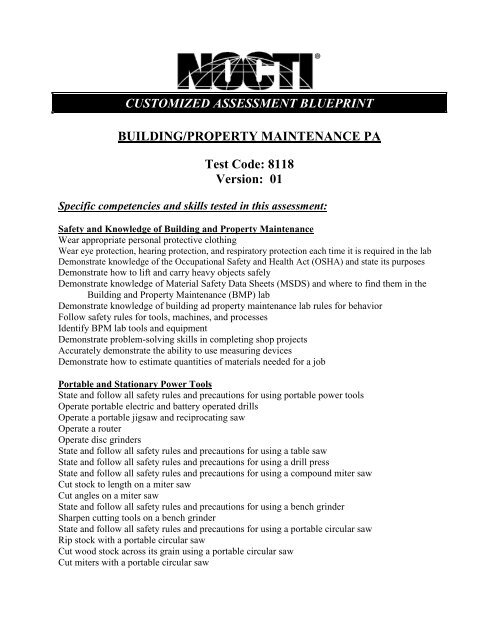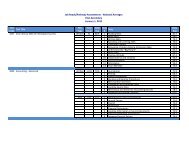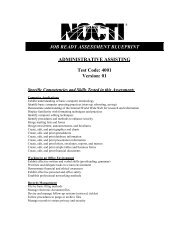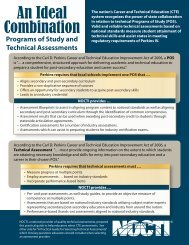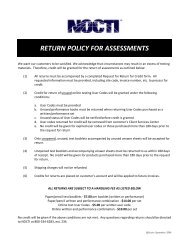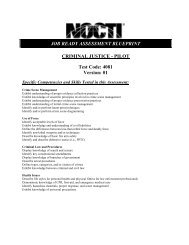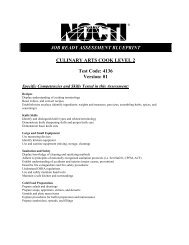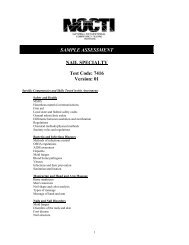Building/Property Maintenance - nocti
Building/Property Maintenance - nocti
Building/Property Maintenance - nocti
You also want an ePaper? Increase the reach of your titles
YUMPU automatically turns print PDFs into web optimized ePapers that Google loves.
CUSTOMIZED ASSESSMENT BLUEPRINT<br />
BUILDING/PROPERTY MAINTENANCE PA<br />
Test Code: 8118<br />
Version: 01<br />
Specific competencies and skills tested in this assessment:<br />
Safety and Knowledge of <strong>Building</strong> and <strong>Property</strong> <strong>Maintenance</strong><br />
Wear appropriate personal protective clothing<br />
Wear eye protection, hearing protection, and respiratory protection each time it is required in the lab<br />
Demonstrate knowledge of the Occupational Safety and Health Act (OSHA) and state its purposes<br />
Demonstrate how to lift and carry heavy objects safely<br />
Demonstrate knowledge of Material Safety Data Sheets (MSDS) and where to find them in the<br />
<strong>Building</strong> and <strong>Property</strong> <strong>Maintenance</strong> (BMP) lab<br />
Demonstrate knowledge of building ad property maintenance lab rules for behavior<br />
Follow safety rules for tools, machines, and processes<br />
Identify BPM lab tools and equipment<br />
Demonstrate problem-solving skills in completing shop projects<br />
Accurately demonstrate the ability to use measuring devices<br />
Demonstrate how to estimate quantities of materials needed for a job<br />
Portable and Stationary Power Tools<br />
State and follow all safety rules and precautions for using portable power tools<br />
Operate portable electric and battery operated drills<br />
Operate a portable jigsaw and reciprocating saw<br />
Operate a router<br />
Operate disc grinders<br />
State and follow all safety rules and precautions for using a table saw<br />
State and follow all safety rules and precautions for using a drill press<br />
State and follow all safety rules and precautions for using a compound miter saw<br />
Cut stock to length on a miter saw<br />
Cut angles on a miter saw<br />
State and follow all safety rules and precautions for using a bench grinder<br />
Sharpen cutting tools on a bench grinder<br />
State and follow all safety rules and precautions for using a portable circular saw<br />
Rip stock with a portable circular saw<br />
Cut wood stock across its grain using a portable circular saw<br />
Cut miters with a portable circular saw
<strong>Building</strong>/<strong>Property</strong> <strong>Maintenance</strong> PA (continued)<br />
Basic Carpentry<br />
Identify common building materials<br />
Read and interpret building plans<br />
Lay out stock<br />
Lay out angles<br />
Use a sliding T-bevel to transfer an angle<br />
Transfer a cut line using a marking gauge<br />
Test a level for accuracy in the vertical and horizontal positions<br />
Test a horizontal surface using a level<br />
Test a vertical surface using a level<br />
Snap a chalk line<br />
Bore a hole with an auger bit<br />
Bore holes with a portable electric drill<br />
Identify and select various nails for a specific job<br />
Drive and remove nails using a claw hammer<br />
Set finish nails with a nail set<br />
Assemble miter joints by nailing<br />
Select and drive screw-type fasteners by hand<br />
Identify bolts, nuts, and washers for a specific repair job<br />
Identify anchors for masonry repair jobs<br />
Identify screws for specific repair jobs<br />
Drive/remove screws with a portable electric drill<br />
Cut a gain for butt hinges and install butt hinges<br />
Regular Tool and Machine <strong>Maintenance</strong><br />
Identify broken tools and replace or repair immediately<br />
Examine power tool and extension cords for damage; replace or repair<br />
Lubricate moving parts of power tools as recommended by the manufacturer<br />
Replace saw blades and other cutting tool accessories when they become dull<br />
Sharpen hand tools, chisels, and drilling or boring bits when they become dull<br />
Practice safety while working on/with machines<br />
Clean mechanical devices<br />
Make machine adjustments for jobs<br />
Define and discuss friction and lubrication<br />
Troubleshoot machine problems
<strong>Building</strong>/<strong>Property</strong> <strong>Maintenance</strong> PA (continued)<br />
Structural Carpentry<br />
Identify floor members<br />
Install joist hangers<br />
Install or replace bridging between joists<br />
Repair plywood sub-flooring on joists<br />
Identify roof members<br />
Identify roof types<br />
Remove and replace a damaged shingle<br />
Demonstrate proper application of sealing compounds and caulking<br />
Repair stair risers and treads<br />
Install or repair a stair railing<br />
Masonry Skills<br />
Practice safety while performing masonry work<br />
Identify common masonry tools<br />
Identify masonry supplies<br />
Identify safety hazards to masonry workers<br />
Mix mortar for block work<br />
Identify and describe uses of block types<br />
Check work for straightness<br />
Strike off a block wall<br />
Clean mortar from block and brick work<br />
Mix mortar for brick work<br />
Identify standard brick bonds<br />
Identify and describe types of brick and their uses<br />
Cut brick and block with a brickset<br />
Build forms for a concrete slab<br />
Mix concrete to a 1-2-3 proportion<br />
Cast a concrete slab<br />
Float concrete<br />
Finish concrete<br />
Patch steps and walkways
<strong>Building</strong>/<strong>Property</strong> <strong>Maintenance</strong> PA (continued)<br />
Interior and Exterior <strong>Building</strong> Components<br />
Cut drywall with a utility knife<br />
Install metal corners prior to finishing drywall<br />
Tape and smooth drywall<br />
Cope an inside corner<br />
Miter an outside corner<br />
Repair suspended ceiling grids and tiles<br />
Estimate the quantity of tile needed for a repair<br />
Discuss tile terminology and applications<br />
Identify adhesives and mortars<br />
List, identify, and explain tile tools and equipment<br />
Install a new exterior lock set<br />
Hang an interior door<br />
Cut and install molding<br />
Trim a door jamb and/or a window unit<br />
Trim a window, stool, apron, casing, and extension jambs<br />
Identify, repair, or replace siding components<br />
Identify, repair, and clean gutter spouting components<br />
Electrical Circuits<br />
Identify and use electrical tools<br />
Identify wire sizes and ampacities<br />
Identify wire types<br />
Use connectors/wire nuts to connect or splice wire<br />
Discuss proper disposal of fluorescent bulbs<br />
Replace extension cord ends – male/female<br />
Install a ground fault circuit interrupting outlet<br />
Install a junction box<br />
Install adjustable bar hanger<br />
Install a light fixture<br />
Install a duplex receptacle<br />
Install a single pole switch<br />
Install a split wire duplex receptacle<br />
Install a 220-volt circuit<br />
Install a recessed light<br />
Bore holes for wire run<br />
Install Romex ® to boxes<br />
Staple Romex ® (non-metallic cable)<br />
according to code<br />
Install a three-way switch<br />
Install BX cable to boxes<br />
Install conduit to boxes<br />
Install rework boxes<br />
Check and replace a 24-volt transformer<br />
Install a GFCI circuit breaker<br />
Demonstrate proper grounding<br />
techniques<br />
Replace a faulty circuit breaker<br />
Install low-voltage wiring<br />
Install coaxial cable for television<br />
reception<br />
Install cabling for computer work<br />
stations<br />
Replace or install a ceiling fan
<strong>Building</strong>/<strong>Property</strong> <strong>Maintenance</strong> PA (continued)<br />
Plumbing Systems<br />
Demonstrate knowledge of basic code regulations for water supply systems<br />
Demonstrate knowledge of basic plumbing code regulations for waste systems<br />
Identify plumbing symbols<br />
Interpret plumbing drawings<br />
Identify types of pipes<br />
Identify plumbing pipe fittings<br />
Measure and cut steel pipe<br />
Thread steel pipe<br />
Install a supply line with steel pipe and fittings<br />
Sweat solder copper pie and fitting using propane, MAPP , or Prestolite gas<br />
Install and replace copper pipe and fittings<br />
Solvent weld PVC (polyvinyl chloride) plastic pipe<br />
Install and repair PVC plastic pipe and fittings<br />
Repair waste water drains<br />
Install, replace, and repair commodes<br />
Install lavatories and sinks<br />
Hook up water supply lines and waste water lines to a bathtub<br />
Install or replace a garbage disposal unit<br />
Clean and/or replace waste water traps and pipes<br />
Replace and repair a faucet set<br />
Identify and replace valves<br />
Finishing Materials<br />
Demonstrate methods for protecting furniture, materials, and surrounding surfaces from overspray<br />
and paint spatter<br />
Demonstrate procedures for taping door and window trim to protect them from finishing materials<br />
being applied<br />
Demonstrate how to prepare a surface prior to applying a finish<br />
Stain wood surfaces with wiping oil stains<br />
Apply a finish material with a brush and a roller<br />
Apply a finishing material with a suction-type spray gun<br />
Apply oil-based paints<br />
Apply acrylic-based paints<br />
Apply a spray finish<br />
Demonstrate proper procedures for cleaning paint brushes and rollers<br />
Environmental Control Systems<br />
Identify the scales on a thermometer<br />
Describe atmospheric pressure and how it is measured<br />
Define BTU (British Thermal Unit)<br />
Describe types of heat transfer<br />
Identify the components of a gas fuel heating system<br />
Identify the components of an oil fuel heating system
<strong>Building</strong>/<strong>Property</strong> <strong>Maintenance</strong> PA (continued)<br />
Written Assessment:<br />
Administration Time: 3 hours<br />
Number of Questions: 200<br />
Areas Covered:<br />
7% Safety and Knowledge of <strong>Building</strong> and <strong>Property</strong> <strong>Maintenance</strong><br />
8% Portable and Stationary Power Tools<br />
15% Basic Carpentry<br />
5% Regular Tool and Machine <strong>Maintenance</strong><br />
5% Structural Carpentry<br />
10% Masonry Skills<br />
10% Interior and Exterior <strong>Building</strong> Components<br />
15% Electrical Circuits<br />
15% Plumbing Systems<br />
5% Finishing Materials<br />
5% Environmental Control Systems<br />
Sample Questions:<br />
Which of the following statements is true when operating a compound miter saw<br />
A. Allow motor to reach full speed before cutting.<br />
B. Start saw with the blade on the stock.<br />
C. Remove scrap while blade is moving.<br />
D. Lift guard to adjust angle.<br />
What type of bolt has a round, smooth head<br />
A. stove bolt<br />
B. carriage bolt<br />
C. flathead bolt<br />
D. hex bolt<br />
What type of nail is used to build concrete formwork<br />
A. common<br />
B. duplex<br />
C. masonry<br />
D. cut<br />
Which tab is removed when installing a split-wire duplex receptacle<br />
A. hot<br />
B. neutral<br />
C. top<br />
D. bottom
<strong>Building</strong>/<strong>Property</strong> <strong>Maintenance</strong> PA (continued)<br />
What type of trap is prohibited for use in a plumbing system<br />
A. grease trap<br />
B. p-trap<br />
C. hair trap<br />
D. s-trap<br />
Performance Assessment:<br />
Administration Time: 3 hours and 30 minutes<br />
Number of Jobs: 6<br />
Areas Covered:<br />
29% Carpentry: Construct Frame<br />
Selection and use of tools, cutting, techniques for assembly, accuracy of board<br />
measurements, and accuracy of frame measurements.<br />
19% Plumbing: Sweat Piping<br />
Use of tools, joining and soldering techniques, accuracy of measurements,<br />
piping support, and leak testing.<br />
14% Electricity: Rough Wiring<br />
Mount electrical boxes, install nonmetallic cable, and preparation of wires in<br />
box.<br />
14% Drywall<br />
Accuracy of measurements and cuts, installation of drywall, and finishing<br />
techniques.<br />
14% Electricity: Finish Wiring<br />
Installation of switching device, installation of light fixture, and testing of<br />
installation.<br />
10% Carpentry: Mortise Hinge<br />
Selection and use of tools, and fit and appearance of installed hinge.<br />
Sample Job:<br />
Carpentry: Construct Frame<br />
Maximum Job Time: 45 minutes<br />
Participant Activity: Two pieces of 2-inch by 4-inch by 8-foot lumber are provided. Using the<br />
diagram provided, cut materials to length, construct miter joint as shown,<br />
construct butt joints as shown, cut and install center stud, and secure frame<br />
to workbench/table with clamps.


